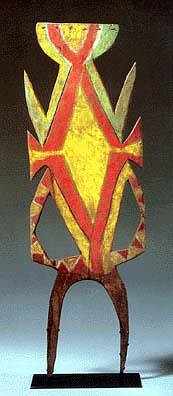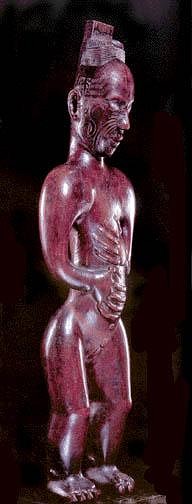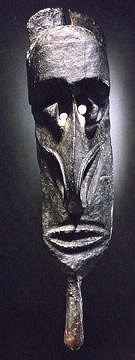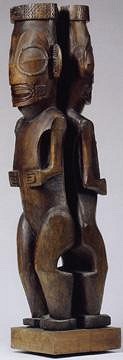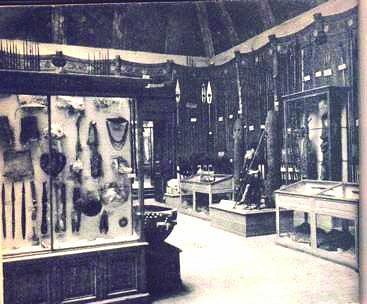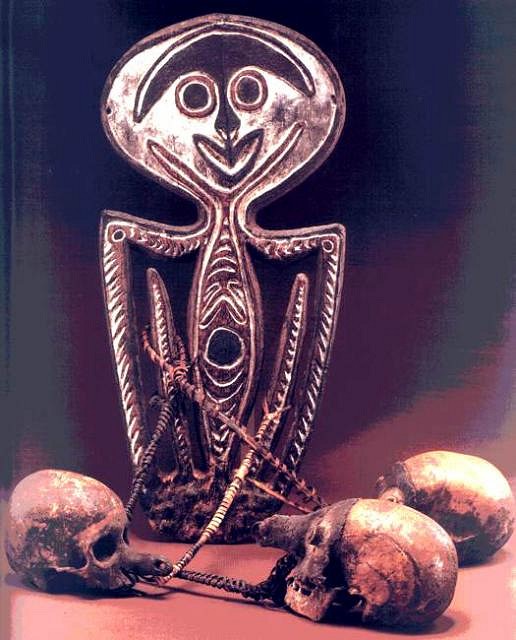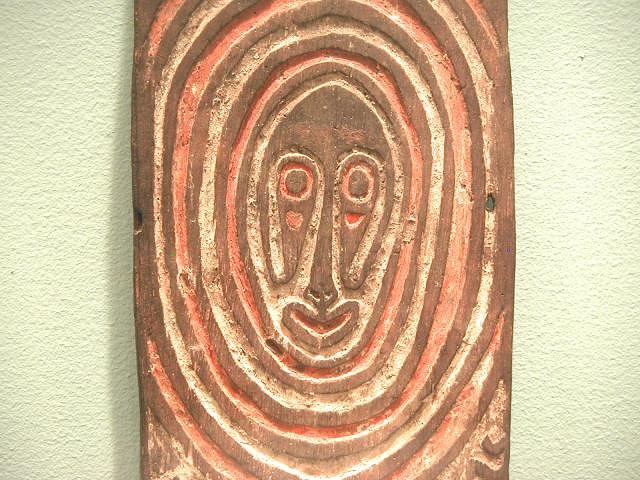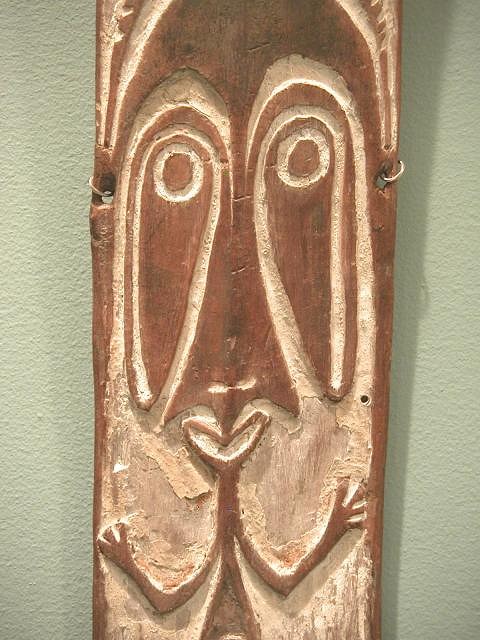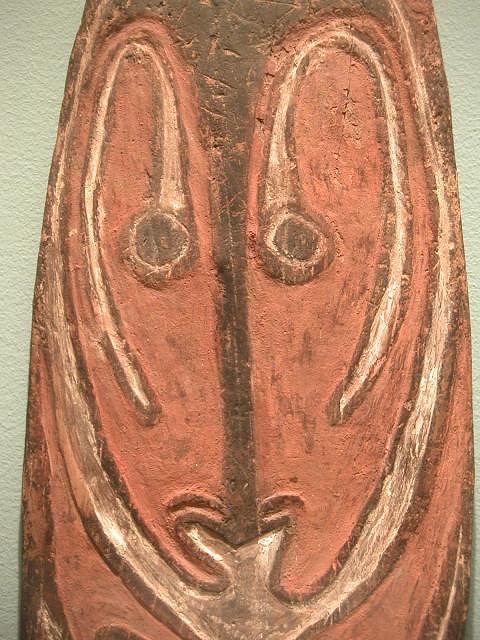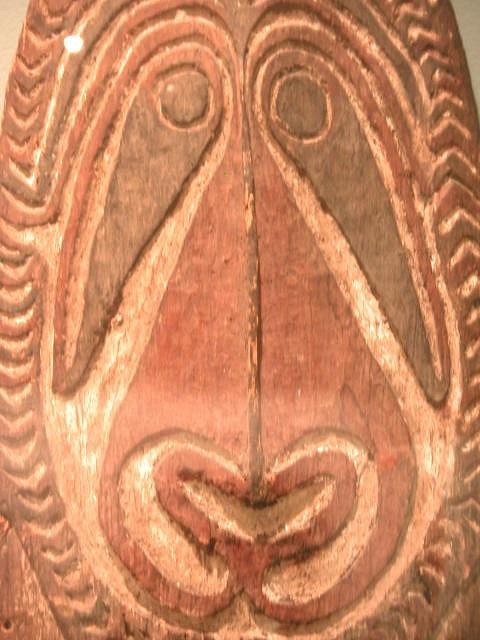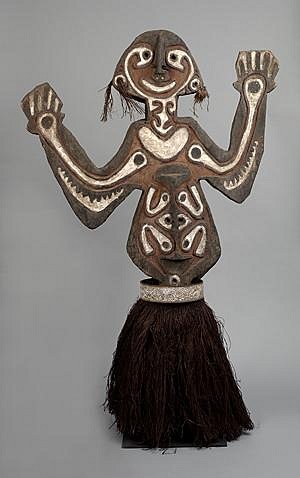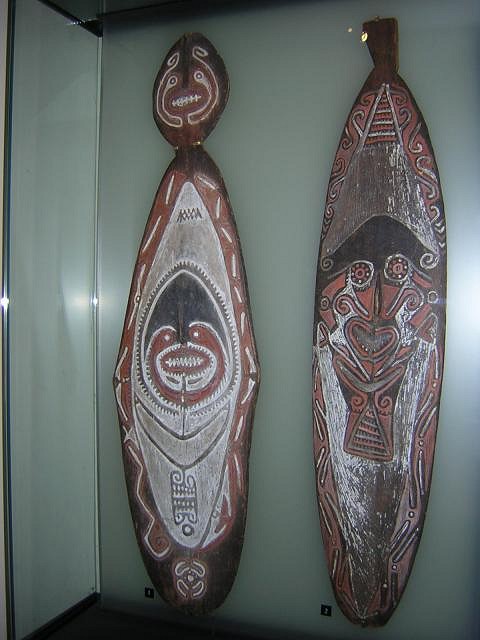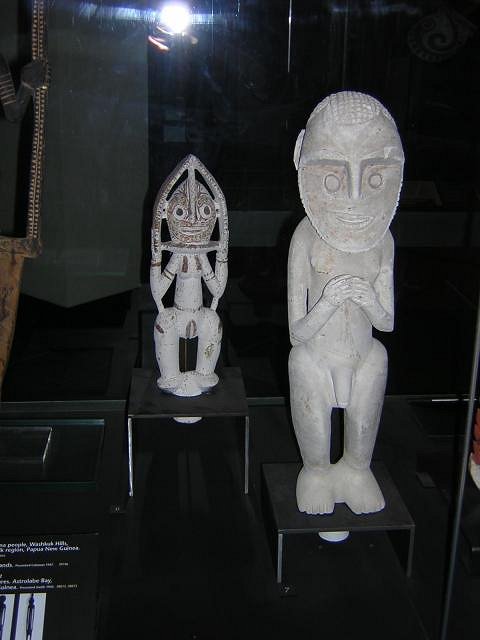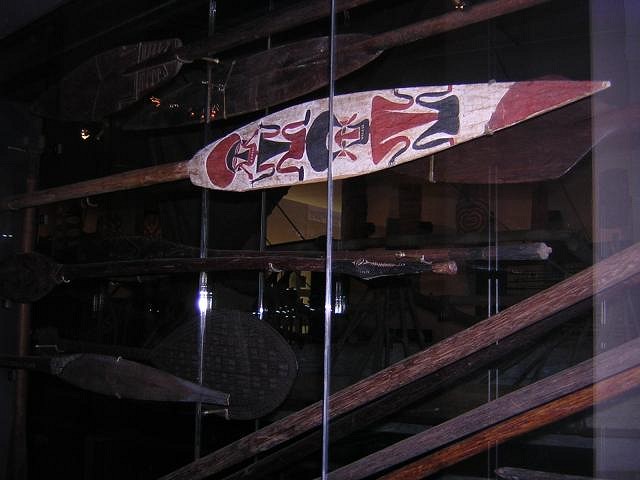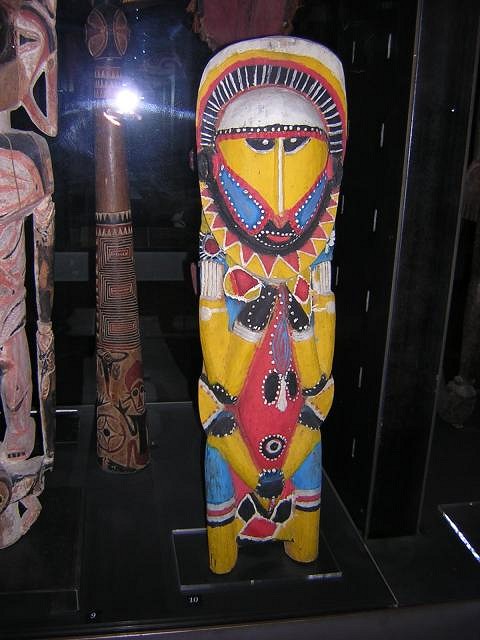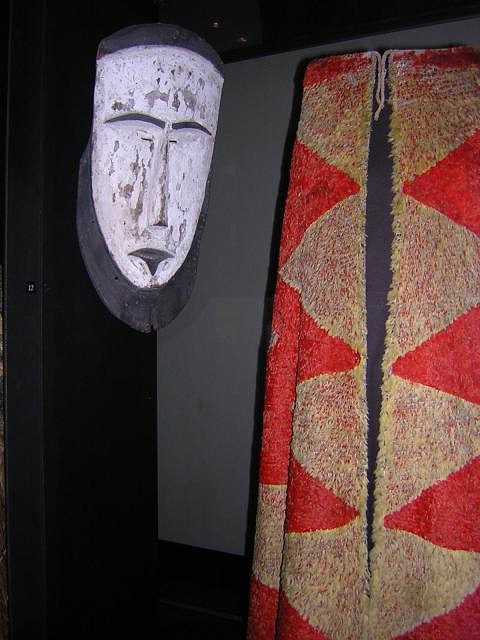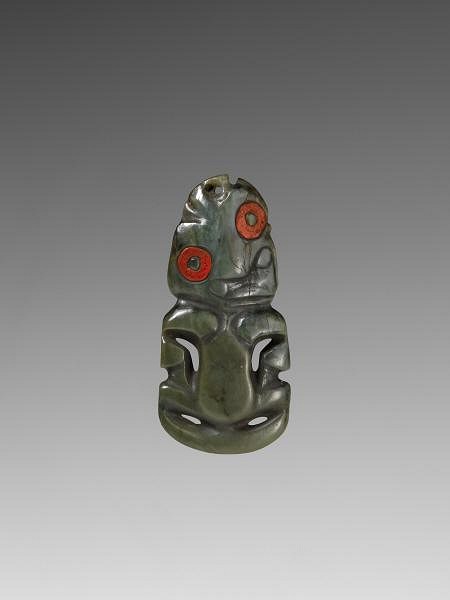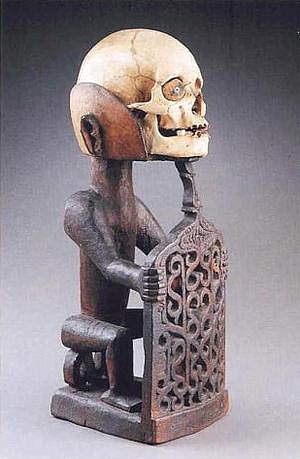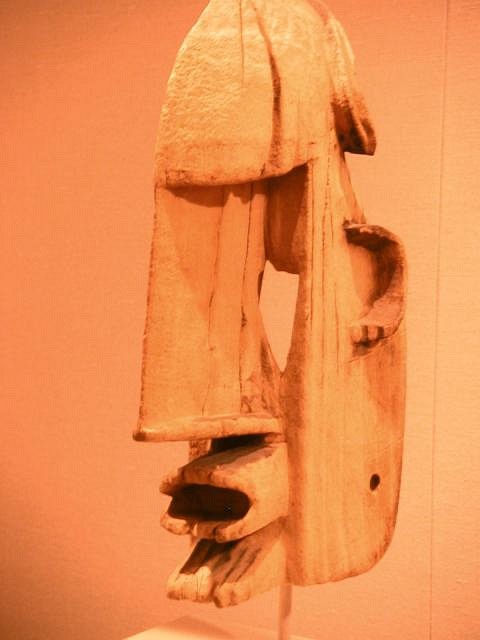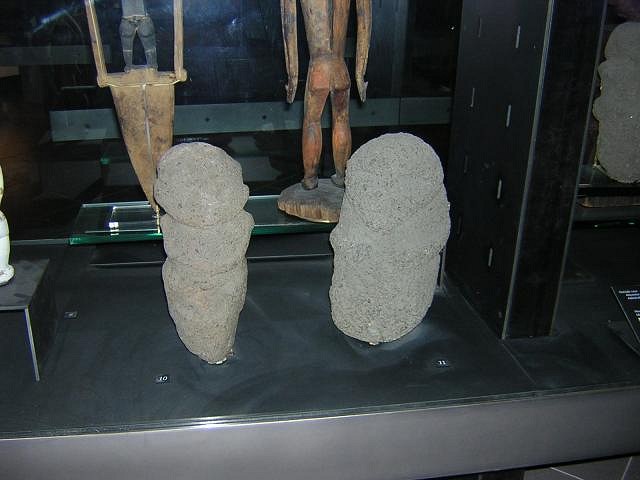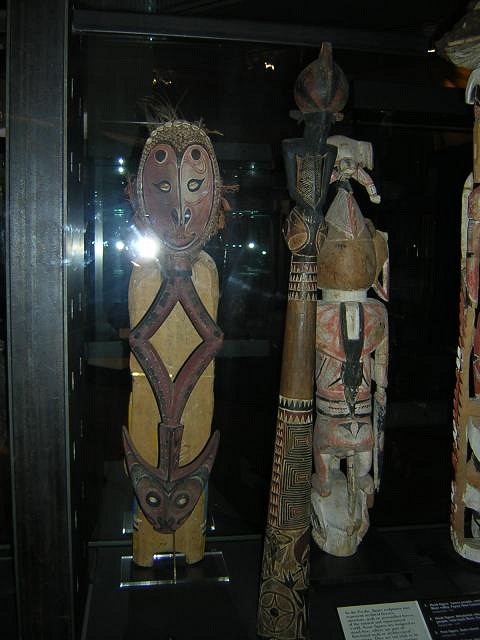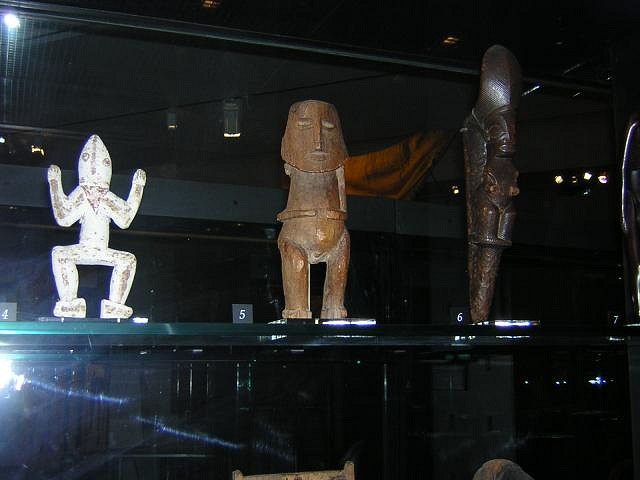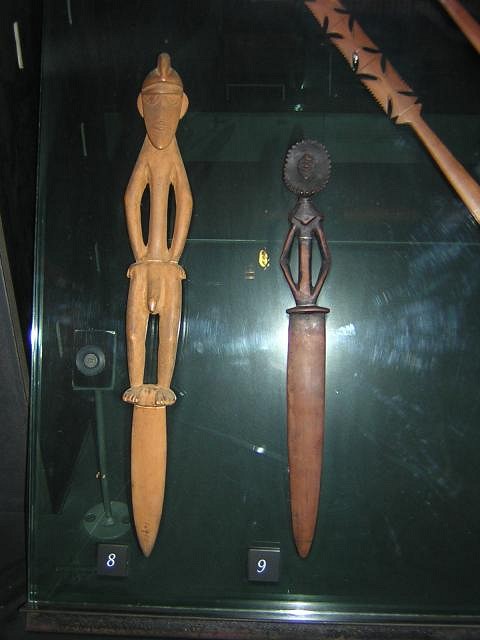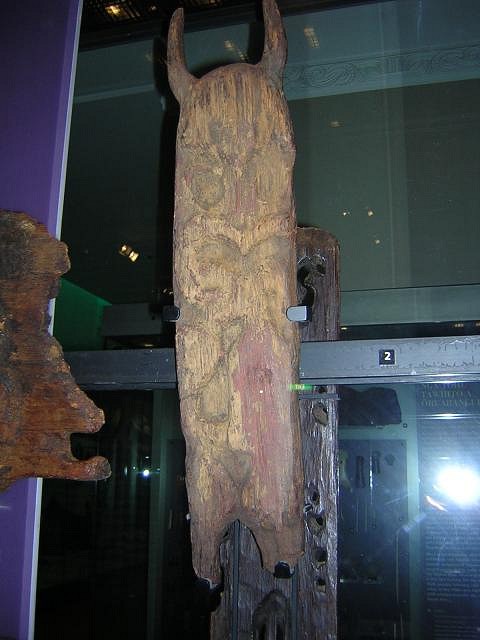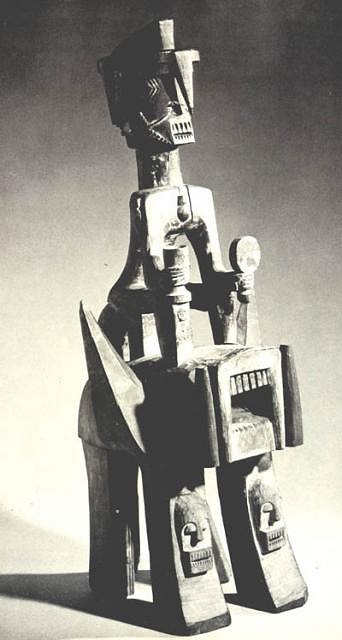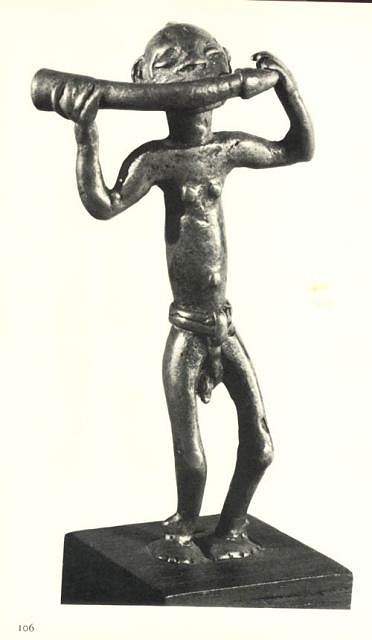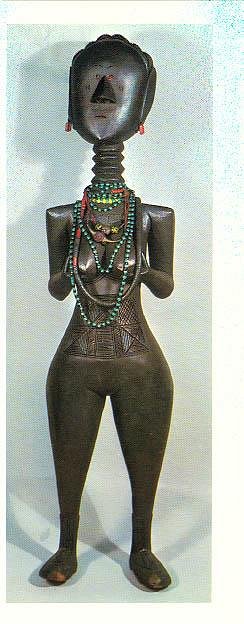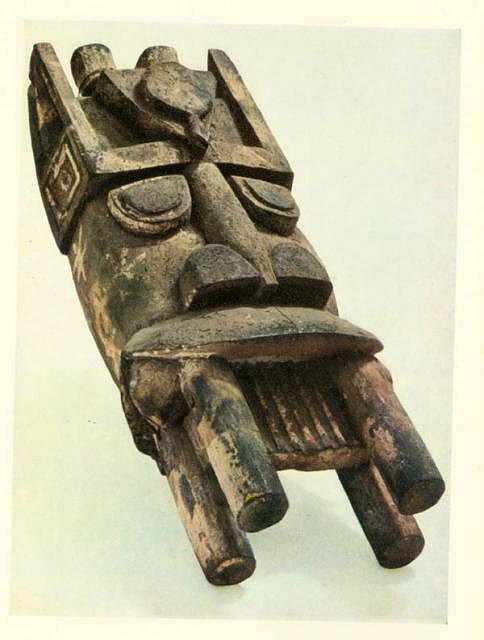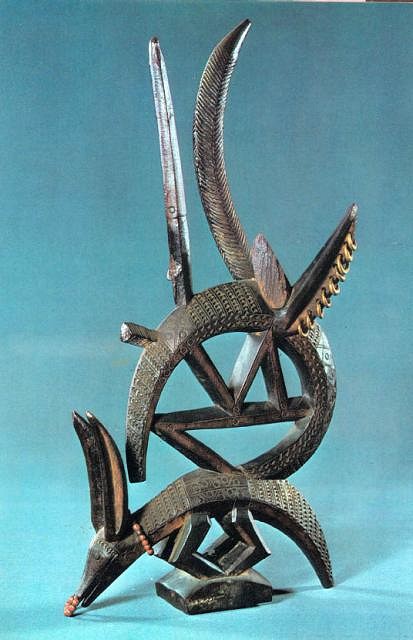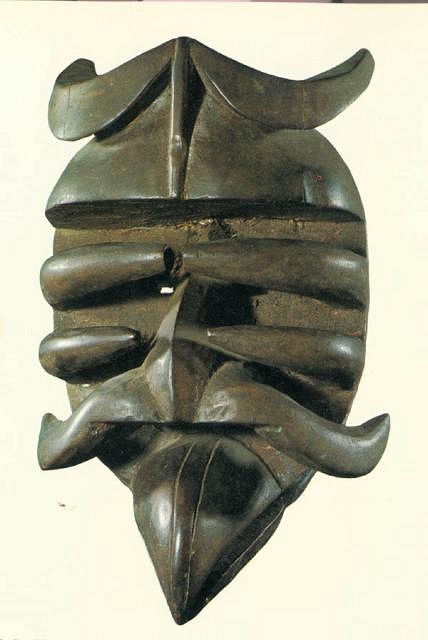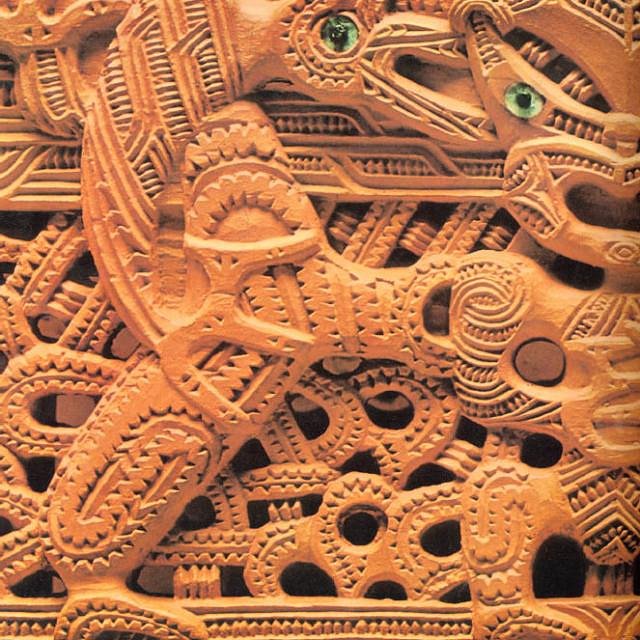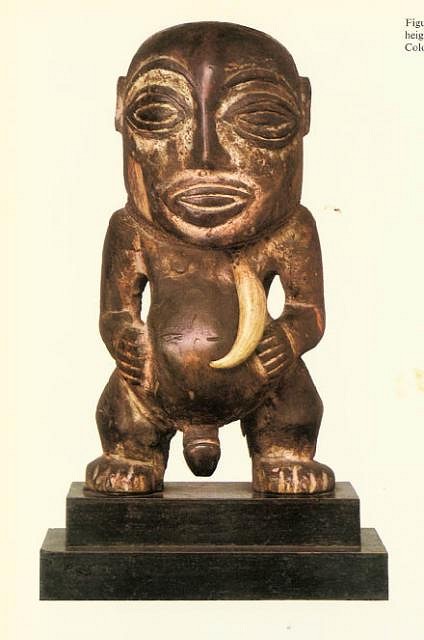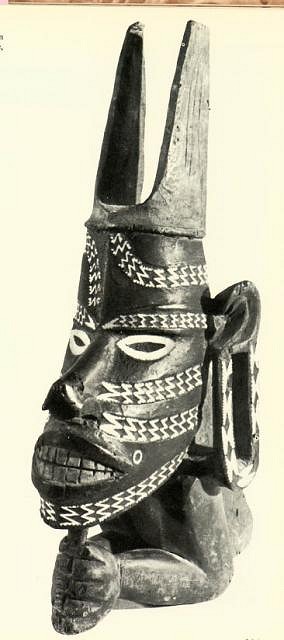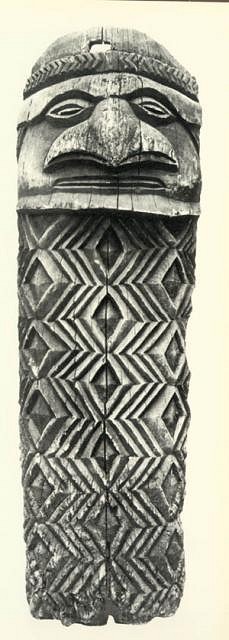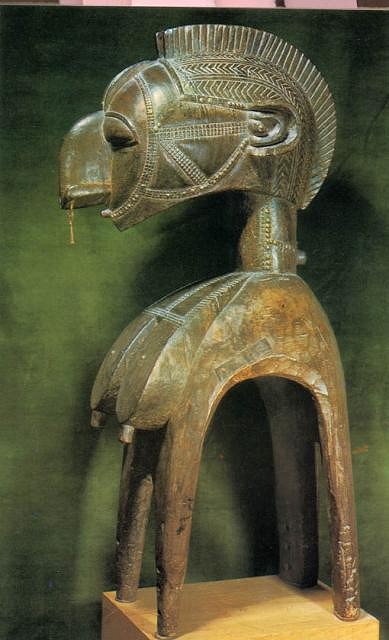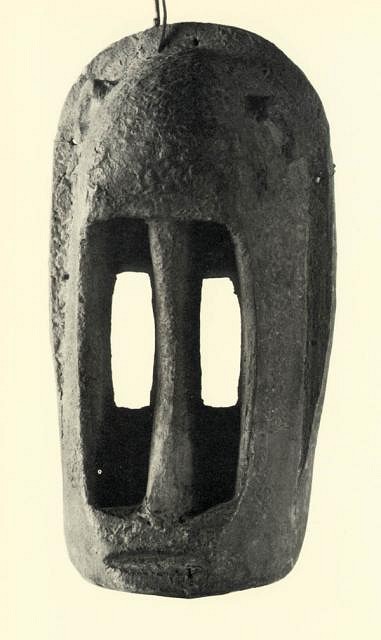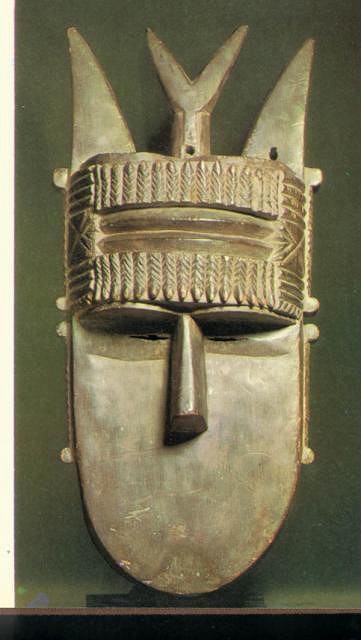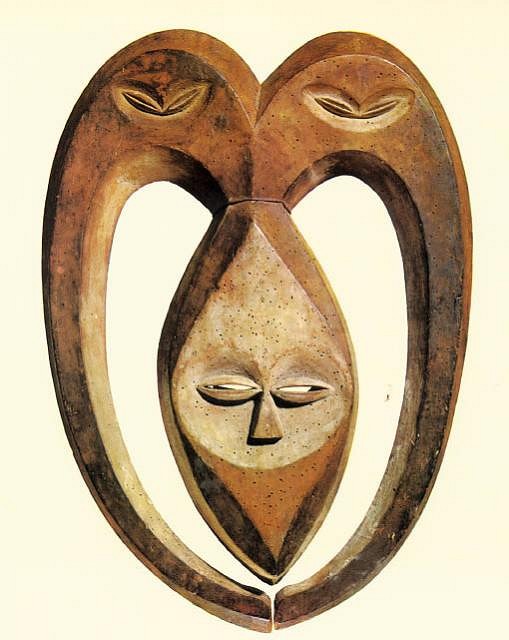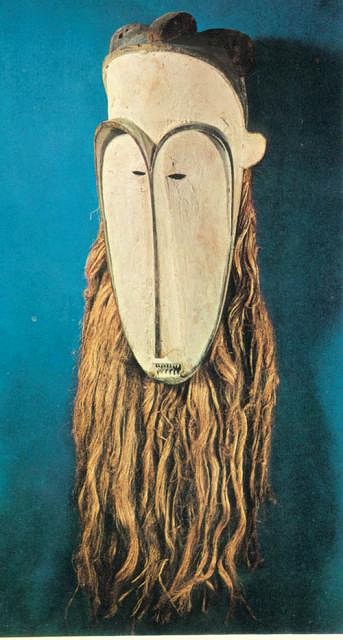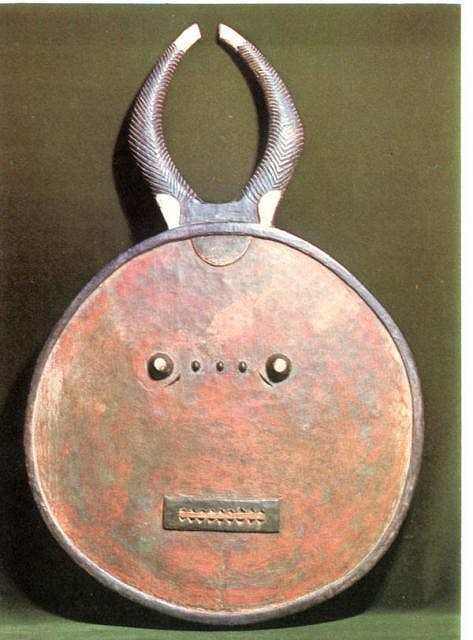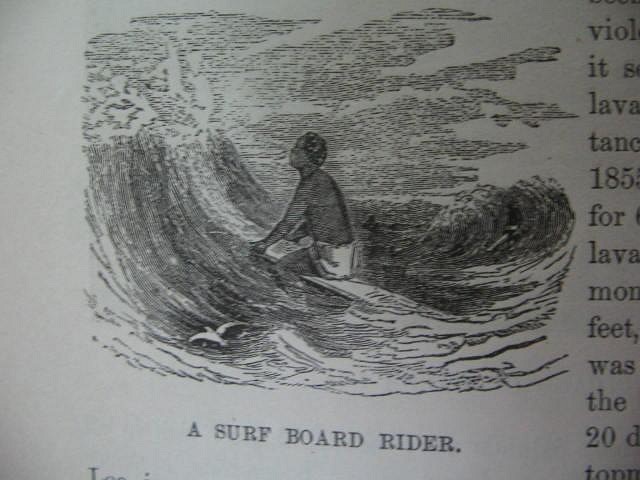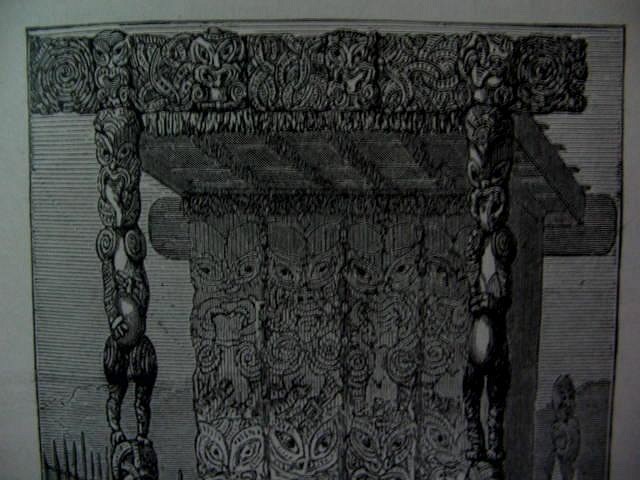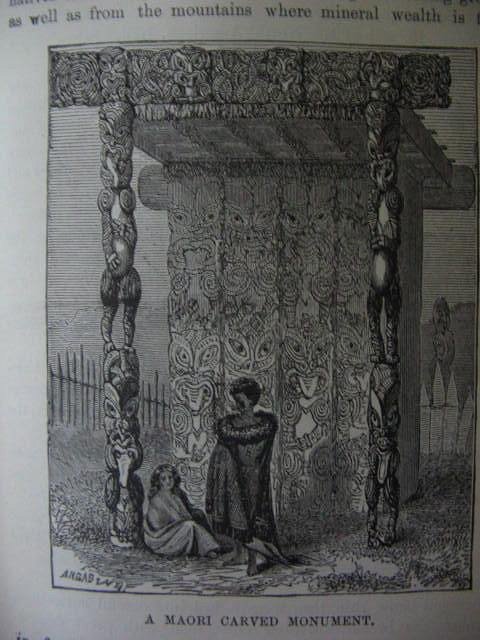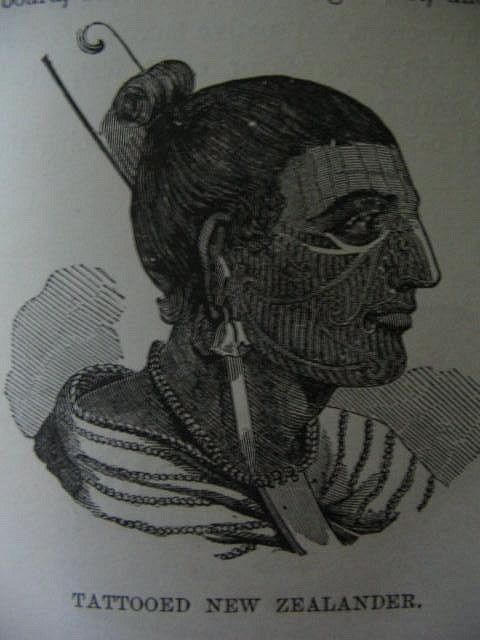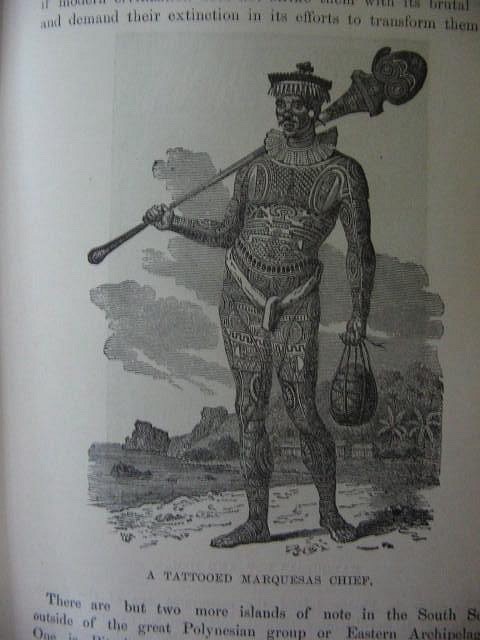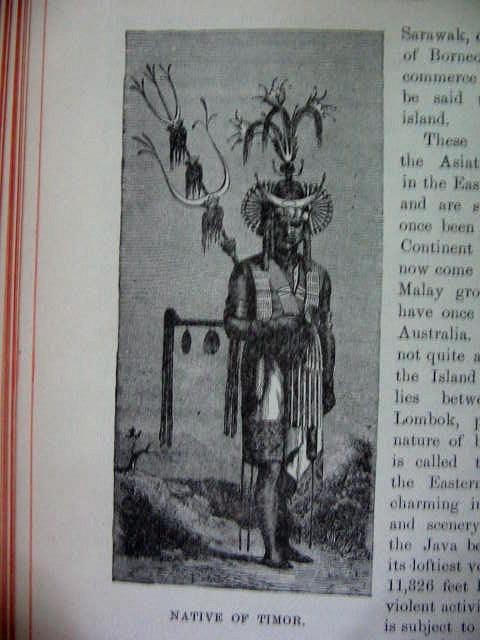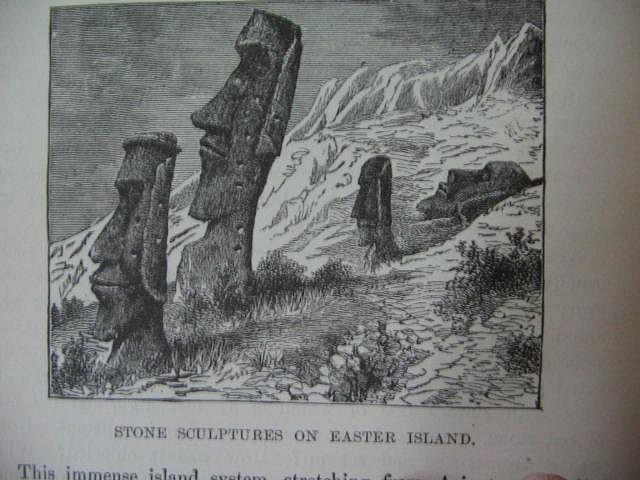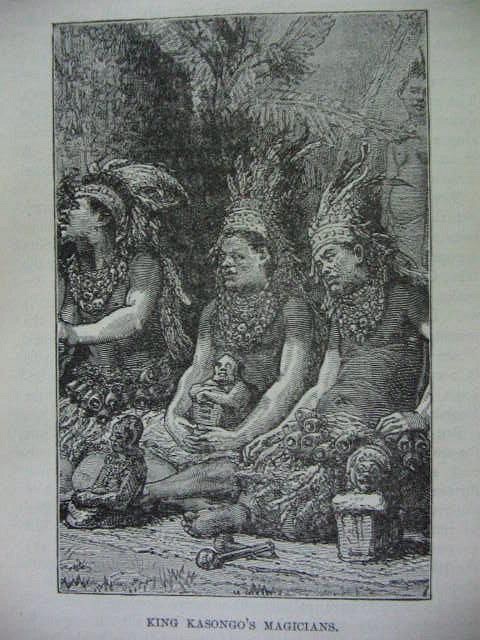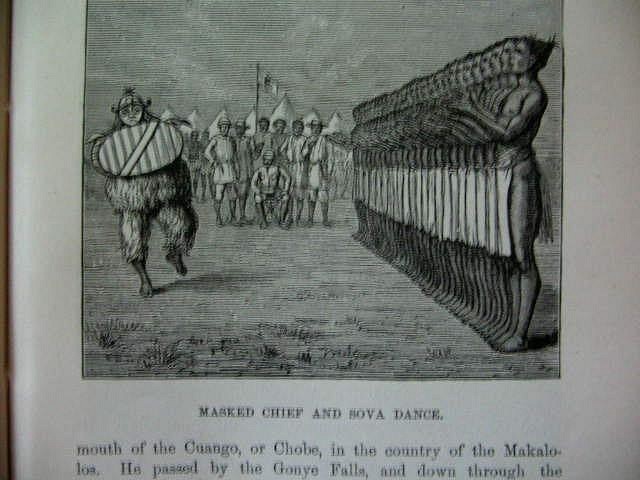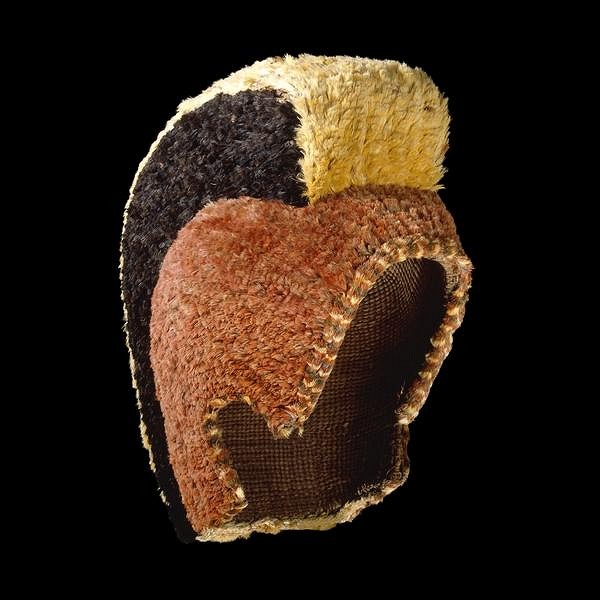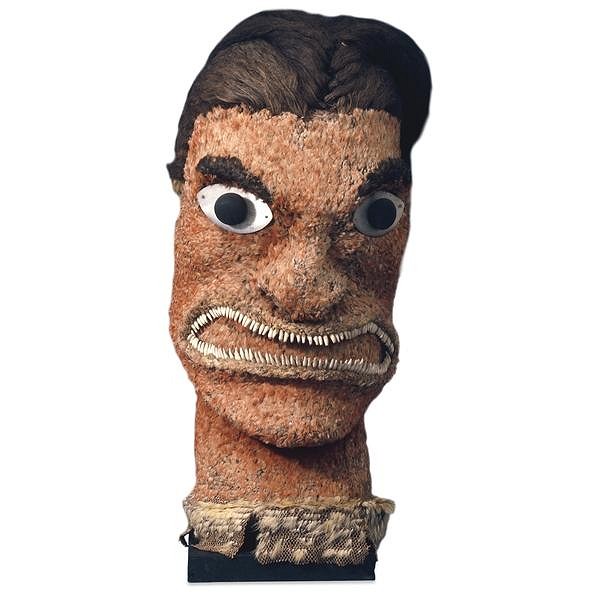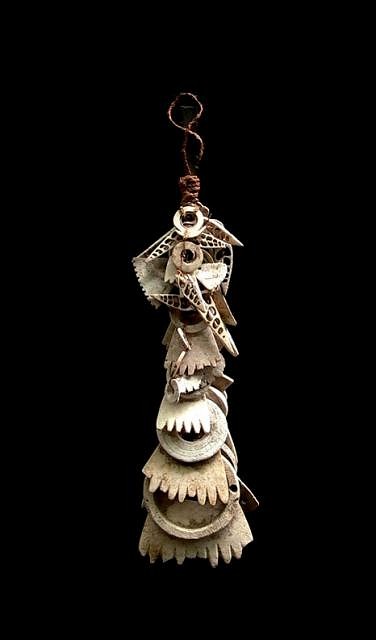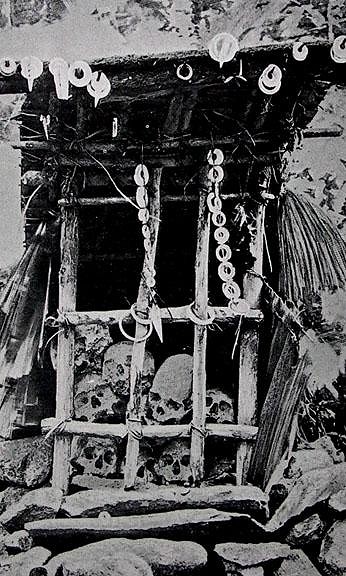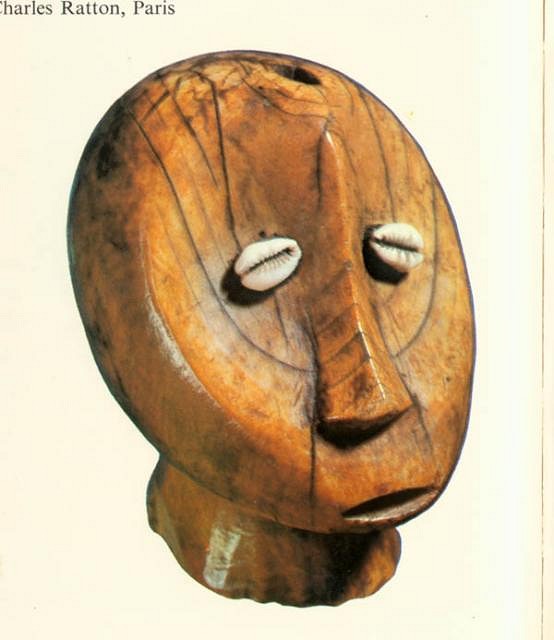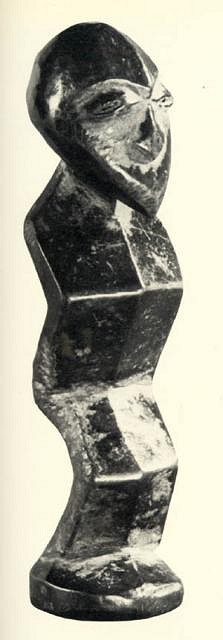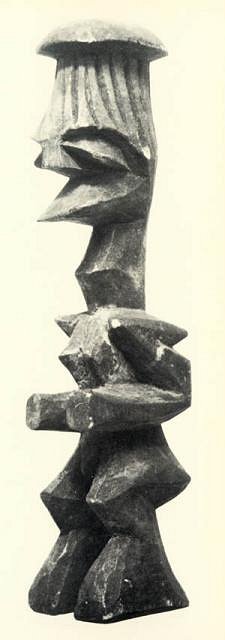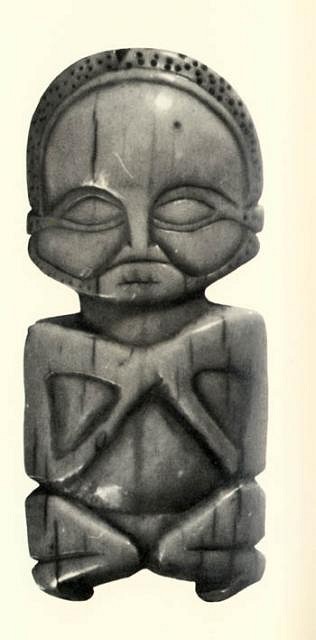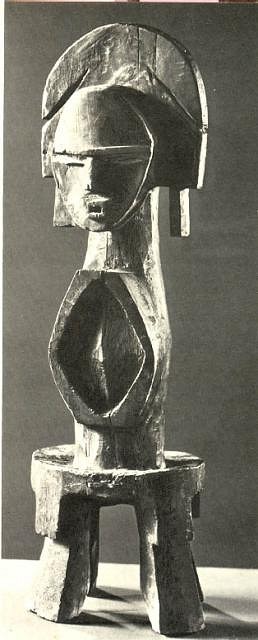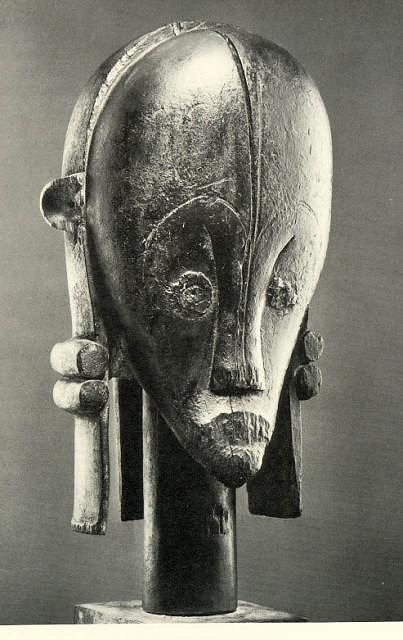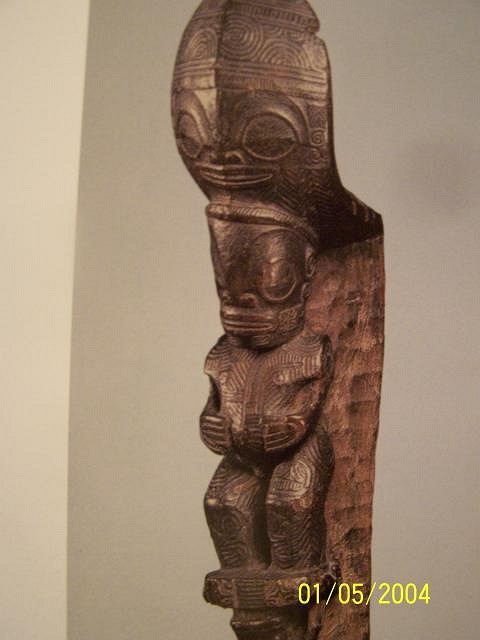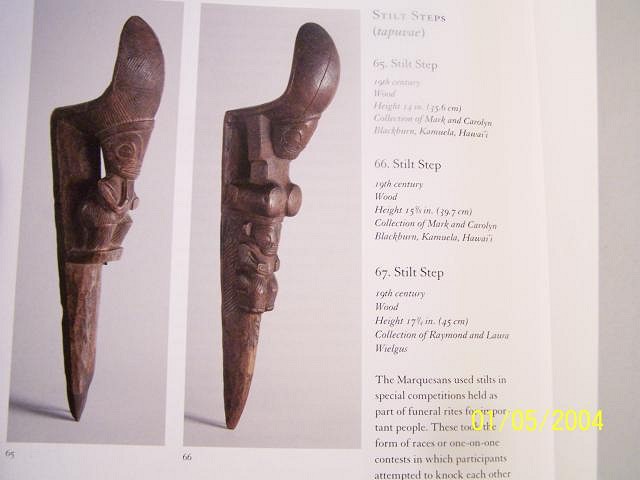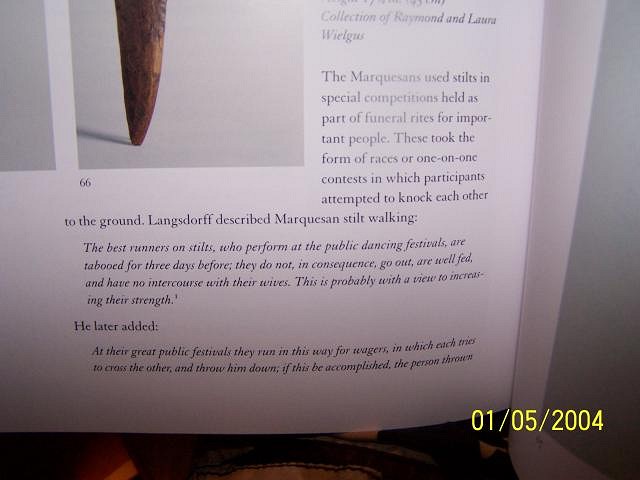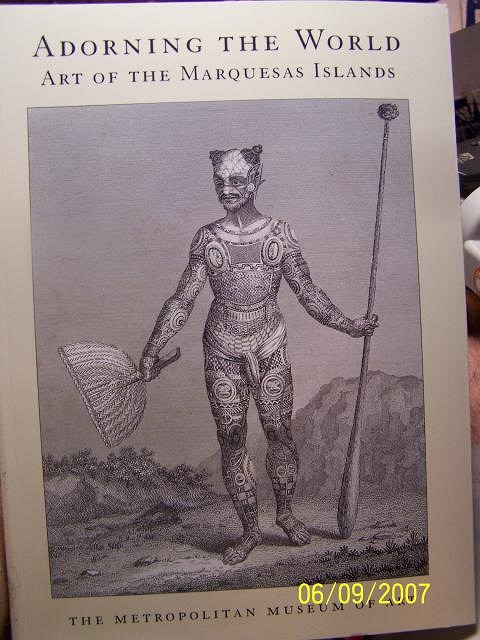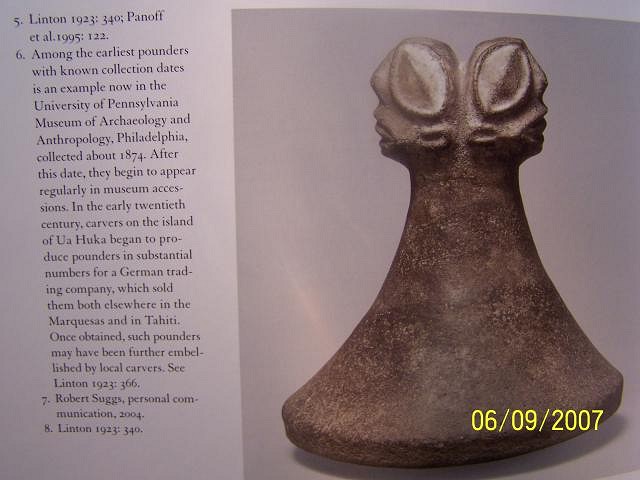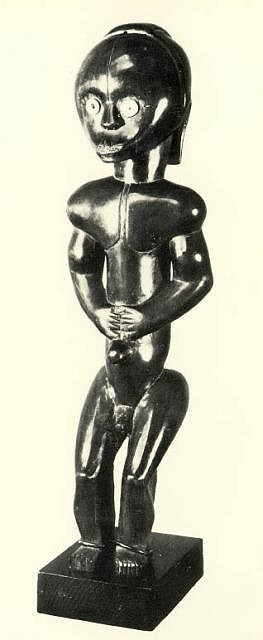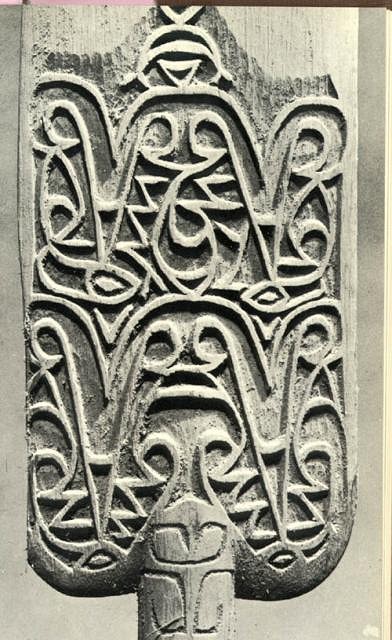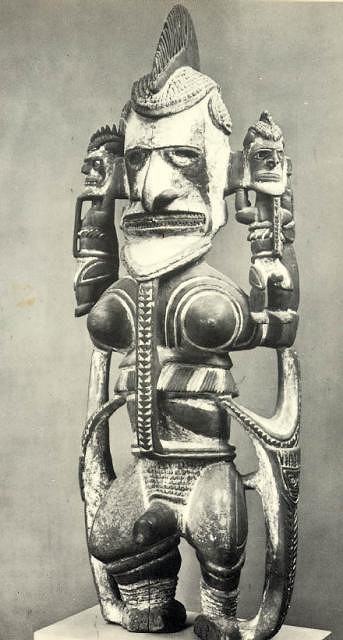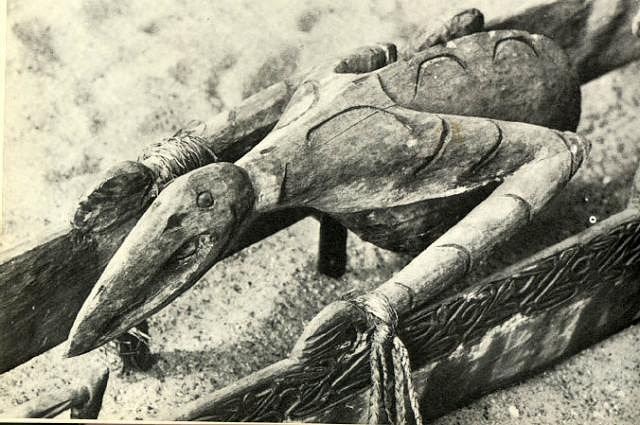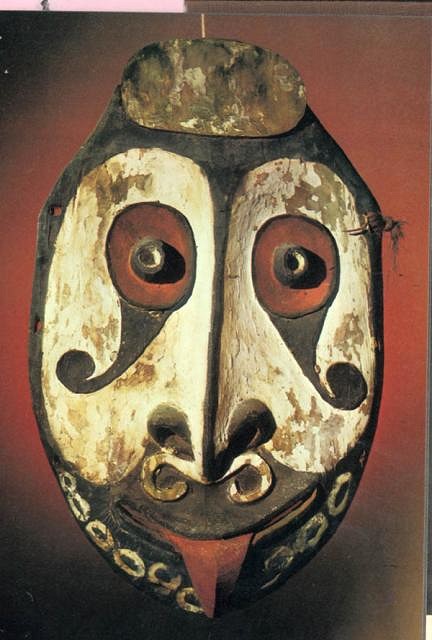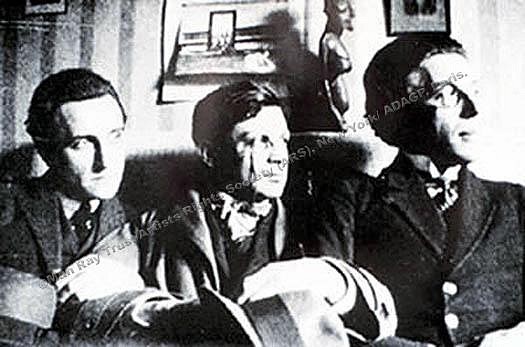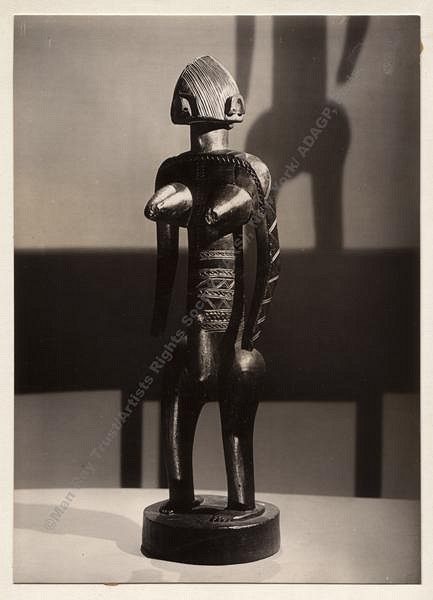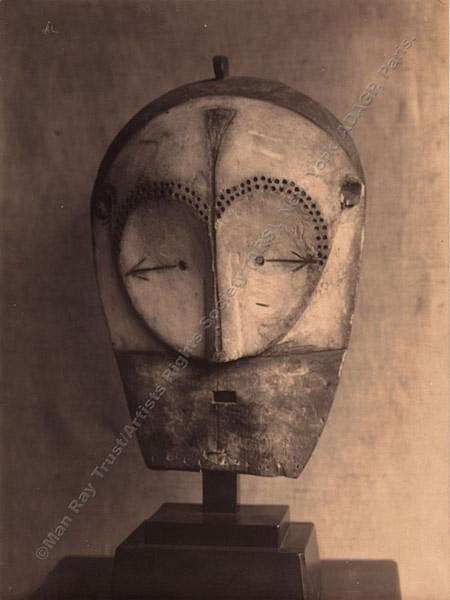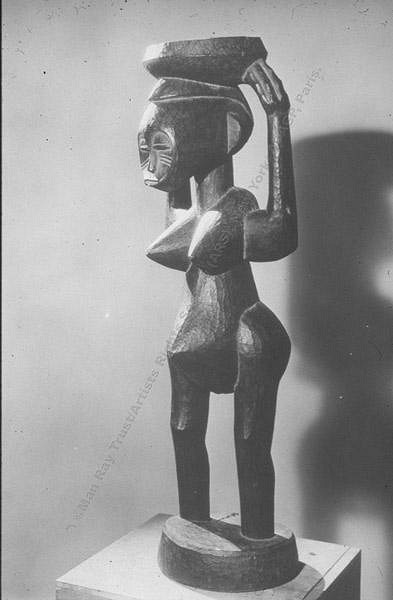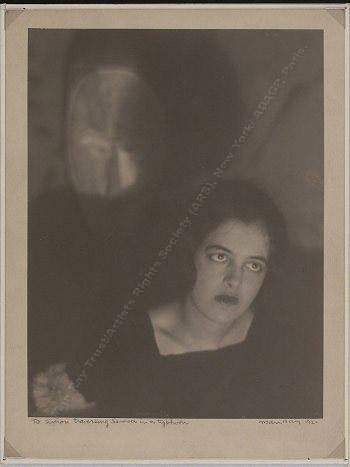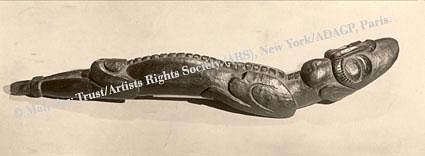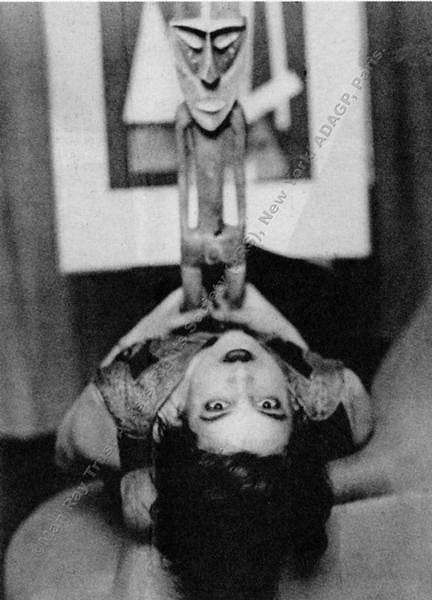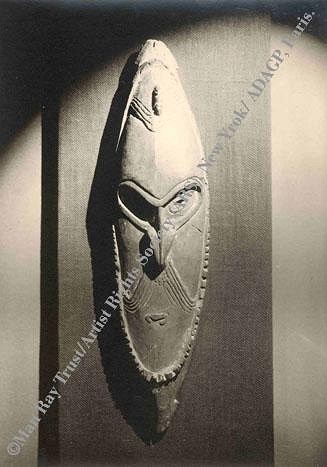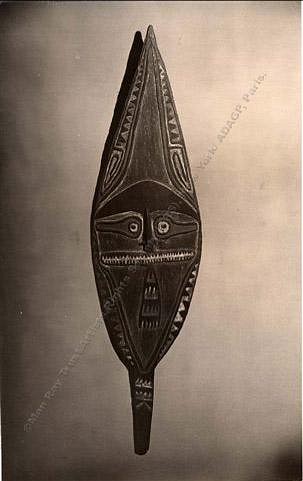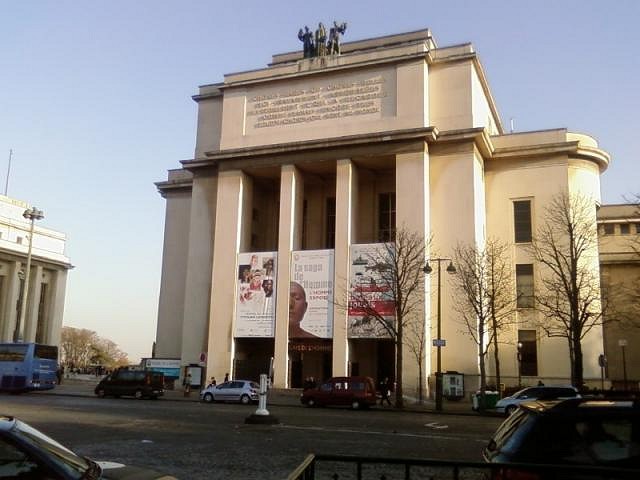Tiki Central / Tiki Carving
Photo Bank: Pre-Contact Oceanic Carvings & Artifacts
Pages: 1 42 replies
|
C
Cammo
Posted
posted
on
Wed, May 16, 2007 3:39 PM
The idea behind this thread is to have a reference bank of Native Tiki photos. They should be original, pre-contact or close to it, interesting native carvings. Photos from out-of-print books, pictures you've taken on site, or shot in museums around the world would be great. Let's not argue terms, you folks get the idea. Attaching a date, type of wood used, location of carving to each would be really helpful. If the dates and locations aren't correct, don't sweat it. A lot of this stuff is hard to track down. These first ones are from a Sotheby's Auction. Cool, huh? New Guinea Highlands, early 20th century. Board figure. Maori Temple Center Post. East Coast Hawkes Bay area of New Zealand, dated to c. 1820. Pentecost Island, Vanuatu mask. C. 1890. Pair of figures from the Marquesas Islands. From the collection of Ambrose Vollard, carved c. 1880. |
|
C
Cammo
Posted
posted
on
Thu, May 17, 2007 12:27 PM
Picture of the 1878 Ethnographic Museum at the Trocadero, Paris World Fair. This was one of the first of the Native Arts Museums, and inspired French artists enormously. This is where Picasso and Matisse learned all about Tikis, about 1906. Photo from 1928. Notice the Tikis to the right, in and around the cabinet. Agiba Skull Rack. Images of Papua New Guinea Spirit Boards, created c. 1910 or before.
Spirit Board - 'Titi Ebiha', New Guinea Papuan Gulf, Kerewa area. Papuan Gulf, Urama Island, Aird Delta, Maiaki Village, near Kinomeri. Irivake figure, a guardian spirit. Very rare, predates 1925. How cool is this guy? |
|
AA

Aaron's Akua
Posted
posted
on
Thu, May 17, 2007 1:08 PM
Excellent idea, Cammo! This will be a great place for people to post "source" photos of ancient, authentic, indigenous, etc. tikis and artifacts. It's a great idea to start with the source and tweak the design from there to something new and original just as Barney West, Milan Guanko, Andres Bumatay, and all of the other tiki carvers did back in the PolyPop era. I'd love to see more. :) A-A |
|
B

Babalu
Posted
posted
on
Thu, May 17, 2007 8:46 PM
Cam, You rock man! Thanks!!....much enjoyment had from this tonight. See ya at the Chop! |
|
T
Tiki-Kate
Posted
posted
on
Thu, May 17, 2007 9:46 PM
I'm going to give this a shot. I have no details though. Just a few pics from New Zealand museums.
|
|
C
Cammo
Posted
posted
on
Thu, May 17, 2007 10:13 PM
Musée du Quai Branly. No more info on the following stuff; Check this out! This jolly little fellow is creepy as hell. And this if from the Met Museum, NYC. It's African, but it totally blew me away when I saw it the first time in person. It's probably originally from the Museum of Primitive Arts, 1957. Cripes, it's all flat planes! |
|
HC
Hula Cat
Posted
posted
on
Fri, May 18, 2007 10:06 AM
Great idea Cam!.....if it works' I have a illustrated book called "The Heavens Earth and Ocean" by James P. Boyd pub.1887 and while it shows "wonders" from the entire world ,it has a chapter titled Isles of the sea where they have engravings of everything from King Kalakaua of Hawaii and a surfer ,tattooing rituals, Maori monuments,Marquesan carvings to the only illustrations I've seen of Easter Island Moai in profile with rows of bowl-like depressions rising vertically along the cheeks and ears.....( I'll post photos as soon as possible) |
|
AA

Aaron's Akua
Posted
posted
on
Fri, May 18, 2007 9:50 PM
Speaking of books... is there a very short answer on how old a book must be for the copyright to expire? I have a few old books (not quite as old as Hula Cat's, though) that would love to share their photos here. |
|
T
Tiki-Kate
Posted
posted
on
Fri, May 18, 2007 9:59 PM
Here are a few more.
|
|
B

Babalu
Posted
posted
on
Fri, May 18, 2007 10:18 PM
Hey Aaron, I think I'm right in saying that a copyright is good for 75 years....remember the whole "Gone with the Wind" thing and it's sequel, however, if passages or images are used in a educational, non profit way, your cool....I say post away. If someone snarls you can always pull them down. http://www.copyright.gov/fls/fl102.html Cool stuff Kate!! See you two tomorrow! |
|
C
Cammo
Posted
posted
on
Mon, May 21, 2007 12:42 PM
Here's some more, from the way out of print classic, "African and Oceanic Art". The following are all African carvings. This one blew away everybody at the Chop Chop last weekend. I dare anybody to find a weirder native carving anywhere. Like, what is he doing, driving an Alien Death Muncher? Ejiri, Guardian Spirit; Ijo, Nigeria. And Babalu actually decided to make his King of the Underwater City of Cthulo tiki have a BIGGER dick after seeing this. Ghana, brass, 4" tall. Sierra Leone Figure. Otobo Water Spirit. Nigeria. Dance Headdress; Bambara, Mali. This one is almost Japanese, but freakier; Wart-hog style dance mask. Liberia. [ Edited by: Cammo 2007-05-21 12:50 ] |
|
C
Cammo
Posted
posted
on
Tue, May 22, 2007 4:43 PM
More stuff. When does this wrap to the next page???? Maori House Panel, detail about 1.5 feet across. Cook Islands God. A little over 1 foot tall. Classic Solomon Islands Boat Figurehead. Nice earrings. Door Panel, New Caledonia. And this one is just great. The Solomons have some really odd carvings, you could make this into a cocktail olive sticker; Fish Figure, Southern Solomon Islands. Wood with Mother of Pearl Inlays, about 6 feet long! |
|
C
Cammo
Posted
posted
on
Thu, May 24, 2007 12:18 PM
More African carvings; these are my ultra favorites. This is one of the all-time classics. These Nimba masks are sometimes seen as the best example of African Primitive style anywhere, maybe bacause they look so other-worldly, but also cause the carving itself is perfect. Nimba Headdress, Baga. Guinea. This on the other hand looks pretty simple. It looks cool, though - Dance of the Dead Mask, Dogon, Mali. Looks like copper, but it's wood - Mask of the Poro Sciety, Guinea Coast. Bakwele, Congo. Yup, one of those Sorcerer Detection masks - Ngi Sorcerer Detection mask, Fang, Gabon. Good Luck Mask, Goti, Ivory Coast. |
|
HC
Hula Cat
Posted
posted
on
Sun, May 27, 2007 2:12 PM
Cammo and any other interested parties, as promised, these are illustrations from the 1887 book that I referred to in an earlier post. The last two images are African, as Cammo expressed an interest in this, and I also included a picture of a surfboard rider and various islanders in tattoo and dress regalia.
at Cammo's request these last two are African first is Zambesi and the second is Congo (note the artifacts) |
|
C
Cammo
Posted
posted
on
Mon, May 28, 2007 7:56 AM
Is that surfer sitting on his board backwards??? Thanks Hula Cat! I've seen a few of those photos reprinted, but the original book is a treasure chest. |
|
C
Cammo
Posted
posted
on
Tue, May 29, 2007 12:46 PM
I've been tracking down the history of the Trocadero Museum, apparently the largest and oldest, and probably most influential collection of Primitiva and Oceanic art on Earth. It's a really bizarre history, and somebody should do a real in-depth study of it, the more I find the crazier it all is. Anything anybody has to add to this, or if anybody has visited the place recently and taken pictures...! Chronologically, then... 1500’s The King of France and various nobles collect “Cabinets of Curiosities”; strange objects collected from around the world by French explorers. 1840’s French colonialism in Africa and the South Seas is rampant. Many Tiki and Primitive artifacts are collected dating from 1790’s – 1820’s. These are taken mostly at gunpoint, as war booty, or simply lifted after an entire village has been burned to the ground. In 1878, The Ethnographic Museum of Scientific Missions opens at the Universal Exposition in Paris, the 3rd French World Fair. This was the first pseudo-scientific institution dedicated to classifying and comparing tribal art specimens from around the world. Intent of the museum is to show how clearly primitive the peoples of Africa and Oceania are, and therefore how necessary French Colonization is. Emphasis is put on collecting bizarre, horrible monstrosities to shock the public. Tikis and scary African mask carvings form the center of the collection. The wild success of this exhibition led to a wing of the Palais du Trocadero becoming dedicated to “tribal art” from around the world. This was, and the collection still is, the largest assembly of African and Oceanic art in the world. 1880 - Musée d'Ethnographie du Trocadéro established. 1887 - Paul Gauguin tours the museum and his paintings begin to change. Not being able to take the museum objects home, he begins to collect African carvings. He is equally influenced, however, by Japanese art. 1891 - Gauguin sails to Tahiti. 1905 - the first painter of the modern era, Maurice de Vlaminck discovers Primitive art. Derain agrees; it was in his studio that Picasso and Matisse saw his white Ivorian mask and were both impressed and disturbed by it. Later that year Matisse sees a mask in Emile Heyman’s shop, and acquires it for fifty francs. He later shows it to Picasso and Appollinaire. 1906 - Matisse is owner of twenty pieces of African and Oceanic art. 1907 - Picasso visits the Trocadero. His is mesmerized and deeply disturbed by the art he finds. The Trocadero by now is damp, evil smelling, with poor displays and empty of visitors. 1907 – Picasso paints his first truly bizarre picture. 1931 - Musée des Arts Africains et Océaniens established, for the ‘Colonial Exposure’ exposition. More Primitive art is collected as it becomes the most popular art in Paris. 1937 - Paul Rivet designs the Museum of Man for the new Paris World’s Fair. This inherits the Ethnographic department of the Trocadero. As of May 3, 2003, the ethnological collections covering the Americas, Africa, Asia and the Pacific close at the Museum of Man, much against the wishes of the directors. Also, the Musée des Arts Africains et Océaniens closes. All objects are now to be displayed in a new museum. Opened in 2006; the Musée du quai Branly. A project led by French President Jacques Chirac, meant as a testament to his regime. More to Come... |
|
B
benella
Posted
posted
on
Tue, May 29, 2007 2:52 PM
Hi Cammo, As a French and tiki addict I visited the "musée du quai Branly" that is very interesting. However, I was a bit disappointed because there's not a lot of Hawaiian, marquesan and maori stuff ;( Thanks for the historical chronology, that's cool :wink: Benjamin. |
|
C
Cammo
Posted
posted
on
Tue, May 29, 2007 3:29 PM
Ben, that's apparently what everybody is mad about! The collection is all sitting in boxes in the cellar, at last count the Oceana artifacts number 30,000 items, but very few are on display. Mon Dieu! I've tried looking up the whole collection on their website but it doesn't work so well. Did you ever see the display at the Museum of Man or the African/Oceania museum before it closed, I'm extremely interested! Any chance of a photo tour of the new place? And any info you have or can collect would be amazing, historical or incidental! (What does the public think of the new place?) Merci, mon ami. |
|
MB
Mr&Mrs BPHoptiki
Posted
posted
on
Tue, May 29, 2007 4:21 PM
I came across this the other day and found it really interesting. from the British Museum, Power & Taboo: sacred objects from the Pacific.
Go here for the online tour Mrs Hoptiki |
|
T
teaKEY
Posted
posted
on
Wed, May 30, 2007 10:25 AM
I found that a good place to look is Ebay. Sometimes when people are listing books they show tons of photos that you wouldn't see any other way. Ok, here is a Ebay item that was on a week or so ago I have been looking at all things Solomon Island lately. My favorite new area.
CONTAINS A WEALTH OF OVER 40 ANCIENT BARAVA ORNAMENTS Originating from the New Georgia region of the Western Solomon Islands, offered is a remarkable charm that would have been attached to a shrine that contained the skulls of important chiefs. It is said that the spirit of the chief would enter the charm. I have included a historic photo (Festetics de Tolna, 1903) that shows several similar but less elaborate charms attached to a shrine enclosure. The charm, sometimes referred to as "funerary money", measures 15 inches in length. Attached to the central stick via sennit and rattan fibers, are forty or more ancient barava ornaments that date to the 18th and 19th centuries. The individual baravas were signs of chiefly wealth and were amassed by chiefs during their lifetimes. This charm was originally purchased from a New Zealand private collection and was reported to have been collected in the early 20th century. It is rare to find such a charm complete with all of its individual barava ornaments intact. When I found the Item it was just US $55.00 but by the end of the bid it climbed to US $1,456.87. [ Edited by: teaKEY 2007-05-30 18:28 ] |
|
C
Cammo
Posted
posted
on
Mon, Jun 4, 2007 4:03 PM
More Carvings! Balega, Congo, 5.5" tall. This one is so simple, but wild. Love to carve something similar. Belega, Congo. 6.25" tall. From the Belgium African Museum. Nigeria, 6.5" tall. Buzzy liked this one - Wish this guy was in color - Congo, Ivory, 4.5" tall. Reliquary Figure, used to ward off evil spirits from the bones of relatives. And this is the big one. This carving, it's not a mask, started in a collection way back in the 1820's. It's been passed off, bought, acquired, and appreciated by artists and the collecting elite since then, and finally ended up in the NY Museum of Primitive Art started by the Rockefellars. It's more or less the centerpiece of the collection, and may be the one carving outside of the Trocadero exhibits that started the whole rush to actually collect African Art! It's currently at the Met in NYC, I saw it a few months ago and was blown away by it's lines and style. What this photo barely shows is that it's carved in two totally different fashions, divided exactly down the center. The hairline and back are perfectly geometric, the face is all swooping curves. It's so well done when you see it in person, and just so modern, it's astounding. Nobody knows who carved it. Gang, Gabon, 1790's? |
|
B
benella
Posted
posted
on
Wed, Jun 6, 2007 4:03 AM
Hi Cammo, Here is a link with some of the sculptures you can see at the musee du quai branly: http://www.quaibranly.fr/index.php?id=603&no_cache=1&sword_list[]=marquises (On the top of the page you can choose english) :wink: I unfortunately didn't see the musee de l'homme and the musee du Trocadero. About the musee du quai Branly, I can tell you that lots of people love it but a few people don't like it too ! Because it is quite a special architecture (Jean Nouvel) and because of the growing of the plants on his wall (that don't grow very fast :) ). Few more info next time! Benjamin. |
|
5HOB

54 house of bamboo
Posted
posted
on
Wed, Jun 6, 2007 9:45 AM
You might like this link for Oceanic art in Paris - be sure to hover over the gallery link and don't miss the additional links to the pictures there. And I have a great museum right on my doorstep here where I live - the University of Cambridge Museum of Archaeology and Anthropology - currently showing Pasifika Styles http://www.pasifikastyles.org.uk/exhibition/ Liz
[ Edited by: 54 house of bamboo 2007-06-06 09:48 ] |
|
S
Sneakytiki
Posted
posted
on
Wed, Jun 6, 2007 9:06 PM
Okay, I'm going to try to help ID some of these. Top pic. are shield/skull racks from N. New Guinea in the Papuan Gulf area. The white and brown female figure in the second from top pic. with hands above her head meeting at center is a Kulap figure from New Ireland, these were mortuary figures from the S. of New Ireland. I believe this figure was collected by the Rev. George Brown in 1878. The mask with white and black elements in the bottom pic. is the only mask style ever recorded from Micronesia. Masks were abundant in Melanesia and altogether lacking in Polynesia. Current theory is that Micronesia was settled from Melanesia from the South, the Phillipines and Indonesia from the West, and from Polynesia from the East. This mask is thought to represent a Melanesian cultural influence. The mask is from Satawan Atoll, Mortlock Islands, Caroline Islands, Federated States of Micronesia. The feather cape to the right of the black and white mask is Polynesian, specifically Hawaiian. In the picture above the feather cape and mask the cone shaped sculpture to the left of the brightly painted Melanesian figure is from Buka, Solomon Islands, Papua New Guinea. The paddle in the picture above the brightly colored New Guinea figure is from Buka, Solomon Islands, New Guinea also. The brightly colored figure is from the Sepik river region of New Guinea, and I'd have to attribute it to the Abelam tribe, as painted it is obviously post contact due to the divergence away from the worldwide very common color scheme of stone-age cultures, red oxide, white clay, black charcoal, and sometimes yellow ochre. That's all for tonight. I thought it was ashamed that these items were not attributed. I hope this is good info. for some of you. Possibly interesting to Tiki Kate. Aloha! [ Edited by: Sneakytiki 2007-06-15 14:22 ] |
|
P
pdrake
Posted
posted
on
Thu, Jun 7, 2007 5:37 PM
if you don't have this book, you should pick it up. it's really nice and has some great illustrations and pictures. |
|
S
Sneakytiki
Posted
posted
on
Thu, Jun 7, 2007 11:09 PM
This is a Korwar figure. They are from (Geelvink Bay), Irian Jaya (West New Guinea). The scrolling patterns on the front are similar to Indonesian openwork canoe prows which the residents of NW New Guinea have as well. Anthropolgically speaking, Indonesia ends after Geelvink bay, that is to say, although half the huge Island of New Guinea is politically Indonesia, this is where the cultural influence/continuity ends. [ Edited by: Sneakytiki 2007-06-07 23:14 ] |
|
C
Cammo
Posted
posted
on
Fri, Jun 8, 2007 4:24 AM
I still think it's creepy as hell, but I'll admit - maybe that's my ethnocentric point of view. Here's a cool resource I've been using for years, ABE Book Search, one of the best search engines for used books, this configuration is arranged from lowest to highest price; http://www.abebooks.com/servlet/SearchEntry?errorcode=1 Often the books are way cheaper than ebay final sales. Good hunting. It's hard nailing the history of lots of these items, without the info right there in front of you - it's almost impossible to take notes in a museum that link up with your shots. I've noticed some patterns emerging, though . . .
|
|
S
Sneakytiki
Posted
posted
on
Fri, Jun 8, 2007 11:35 AM
You could put the "olives" inside the figure, as this is in fact a skull reliquary that would hang from the roof beams. It contained revered skulls, sometimes ancestors bones as well. The fish represented is a Bonito, a fish whose hunting prowess is admired by the islanders. These pictures are great, thanks for posting them! As far as the Korwar figure being creepy, I think it is cultural norms, the Korwar is the Western equivalent of having Grampa's ashes and sometimes maybe talking to his ashes or "headstone". ST [ Edited by: Sneakytiki 2007-06-09 09:26 ] |
|
S
Sneakytiki
Posted
posted
on
Sat, Jun 9, 2007 12:42 AM
|
|
HOK
HOUSE OF KU
Posted
posted
on
Sat, Jun 9, 2007 4:17 AM
|
|
S
Sneakytiki
Posted
posted
on
Sat, Jun 9, 2007 9:19 AM
Stilt, COOL, thanks House of KU! |
|
B
benella
Posted
posted
on
Sat, Jun 9, 2007 10:33 AM
Thanks for the stilts House of Ku. Very beautiful. Benj |
|
HOK
HOUSE OF KU
Posted
posted
on
Sat, Jun 9, 2007 5:45 PM
Mahalo Benji and ST...a link to some Hawaiian sled info http://images.google.com/imgres?imgurl=http://www.hawaiibc.com/images/pose_03.jpg&imgrefurl=http://www.hawaiibc.com/home.htm&h=285&w=475&sz=15&hl=en&start=34&tbnid=IthzhAFajr7duM:&tbnh=77&tbnw=129&prev=/images%3Fq%3Dhawaiian%2Bsled%26start%3D21%26gbv%3D2%26sv Freddie |
|
B
benella
Posted
posted
on
Sat, Jun 9, 2007 7:15 PM
Hello Freddie, thanks again for the sleds, I just didn't know what it was and it is very interesting. What is the book you took your scans of marquesan stilts from ? There's something very stupid in France: no book about marquesan art whereas the mrquesas islands mostly speak french... Benjamin |
|
HOK
HOUSE OF KU
Posted
posted
on
Sun, Jun 10, 2007 1:34 AM
[ Edited by: HOUSE OF KU 2007-06-10 01:37 ] [ Edited by: HOUSE OF KU 2007-06-10 01:38 ] |
|
V
VampiressRN
Posted
posted
on
Sun, Jun 10, 2007 3:26 PM
I was lucky to be able to tour the Auckland Museum when I was in New Zealand a couple of years ago. The collection is absolutely breath taking. My visit was pre-Tiki Central, so had never seen any of the artwork here...the museum was my first introduction to the Maori culture. If you are ever in Auckland...this museum is a must visit. Some of the exhibits of items are absolutely huge...like the canoes. I found the section that housed the jewelry and clothing to be my favorite. I now wish we had taken the time to attend the Maori dance presentation. I am really enjoying all the pictures posted here. Great thread!!! |
|
B
benella
Posted
posted
on
Wed, Jun 13, 2007 7:08 AM
Hey, Thanks Freddie for the title of the book, I've just bought it on amazon today. Benjamin |
|
HOK
HOUSE OF KU
Posted
posted
on
Wed, Jun 13, 2007 3:13 PM
Thats where I got mine after I saw it listed on Ebay for alot more...I think you'll enjoy this book, many pictures. Freddie [ Edited by: HOUSE OF KU 2007-06-13 15:14 ] |
|
C
Cammo
Posted
posted
on
Mon, Jun 18, 2007 10:22 AM
Here's the last from the book "African and Oceanic Art", Trowell & Nevermann. (Doesn't 'Nevermann' sound like a TC name?) This book is chock-full of great photos, I'm just cherry-picking the ones I find most interesting; Reliquary figure, Fang, Gabon. From the Plass Collection, British Museum, London. Paddle blade, Asmat, former Dutch New Guinea. Uli figure, New Ireland, Bismarck Archipelago. Very ancient design. Bird figure, from a Soul Boat offering, Asmat, former Dutch New Guinea. Mask, Sepik River District, NE. New Guinea, about 27" tall. |
|
G
GMAN
Posted
posted
on
Mon, Jun 18, 2007 3:05 PM
|
|
C
Cammo
Posted
posted
on
Mon, Jun 25, 2007 6:15 PM
Museum Copyright *This mirrors my problems with some museums NOT ALLOWING "SF author and copywonk Cory Doctorow had visited the So he asked about it. No, they weren’t in copyright. No, Doctorow makes the passionate, strident, and quite correct Copyright (ostensibly) exists to ensure that a creator is Which is of course, also the reason we have museums and art The argument, is of course, not that simple. Museums are Well, only up to a point, in my view. I firmly believe But even aside from that argument, there is of course But on the other hand, surely it’s mostly Modern Art [ Edited by: Cammo 2007-06-25 18:20 ] |
|
C
Cammo
Posted
posted
on
Tue, Oct 9, 2007 8:17 AM
Man Ray photos majorly helped popularize Primitiva and Oceanic Art in the 1920's, especially among the noveau Parisian art collecting world. One of the pictures below appears in Sven's Tiki Modern. But modern it ain't. And check out Tribal Arts Magazine - a quarterly. Here's their website; http://www.tribalartmagazine.com/a_la_une.php All Man Ray photos; Jacques Rigaut, Tristan Tzara and André Breton. Bamana Figure Fang Mask Senufo Figure Simone Kahn with Fang Mask Moko Miro Sculpture, Easter Island Simone Kahn again, with Vanuatu Figure Lower Sepik Mask, Papua New Guinea Gope Board |
|
B
benella
Posted
posted
on
Wed, Nov 7, 2007 12:03 AM
Hi, I finally found the time to take a picture of the musée de l'homme at the Trocadero in Paris:
If anyone planned to visit it, now you know how it looks like because there are one "building" on each side of the place: on the left of the place (you can see a bit of it on the left of the picture): the museum of architecture and the Chaillot theater and on the right of the place: the museum of the Man and the Museum of the Marine. Benjamin. |
Pages: 1 42 replies

